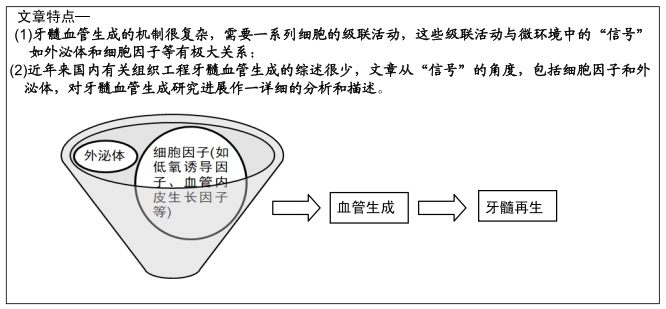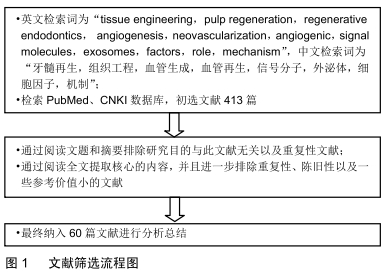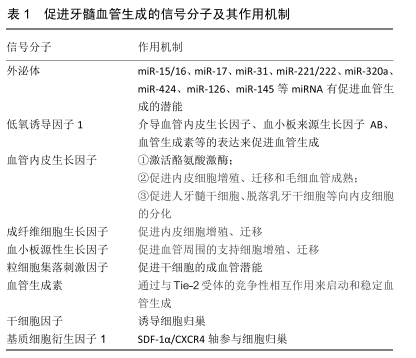[1] ROUWKEMA J, RIVRON NC, VAN BLITTERSWIJK CA. Vascularization in tissue engineering. Trends Biotechnol. 2008 26(8):434-441.
[2] ZHU X, ZHANG C, HUANG GT, et al. Transplantation of dental pulp stem cells and platelet-rich plasma for pulp regeneration. J Endod. 2012;38(12):1604-1609.
[3] ZHANG Y, LIU Y, LIU H, et al. Exosomes: biogenesis, biologic function and clinical potential. Cell Biosci. 2019;9:19.
[4] THÉRY C, ZITVOGEL L, Amigorena S. Exosomes: composition, biogenesis and function. Nat Rev Immunol. 2002;2(8):569-579.
[5] MECKES DG JR, RAAB-TRAUB N. Microvesicles and viral infection. J Virol. 2011;85(24):12844-12854.
[6] Ribeiro MF, Zhu H, Millard RW, et al. Exosomes Function in Pro- and Anti-Angiogenesis. Curr Angiogenes. 2013;2(1):54-59.
[7] 柳鑫,肖燕,江川,等.牙髓干细胞来源外泌体诱导内皮细胞血管生成能力的研究[J].牙体牙髓牙周病学杂志, 2018,28(4):187-196.
[8] HUANG CC, NARAYANAN R, ALAPATI S, et al. Exosomes as biomimetic tools for stem cell differentiation: Applications in dental pulp tissue regeneration. Biomaterials. 2016;111:103-115.
[9] XIAN X, GONG Q, LI C, et al. Exosomes with Highly Angiogenic Potential for Possible Use in Pulp Regeneration. J Endod. 2018; 44(5):751-758.
[10] STANKO P, ALTANEROVA U, JAKUBECHOVA J, et al. Dental Mesenchymal Stem/Stromal Cells and Their Exosomes. Stem Cells Int. 2018;2018:8973613.
[11] ALCAYAGA-MIRANDA F, VARAS-GODOY M, KHOURY M. Harnessing the Angiogenic Potential of Stem Cell-Derived Exosomes for Vascular Regeneration. Stem Cells Int. 2016; 2016:3409169.
[12] GONZALEZ-KING H, GARCÍA NA, ONTORIA-OVIEDO I, et al. Hypoxia Inducible Factor-1α Potentiates Jagged 1-Mediated Angiogenesis by Mesenchymal Stem Cell-Derived Exosomes. Stem Cells. 2017;35(7):1747-1759.
[13] ARANHA AM, ZHANG Z, NEIVA KG, et al. Hypoxia enhances the angiogenic potential of human dental pulp cells. J Endod. 2010; 36(10):1633-1637.
[14] ZIMNA A, KURPISZ M. Hypoxia-Inducible Factor-1 in Physiological and Pathophysiological Angiogenesis: Applications and Therapies. Biomed Res Int. 2015;2015:549412.
[15] AHMED NE, MURAKAMI M, KANEKO S, et al. The effects of hypoxia on the stemness properties of human dental pulp stem cells (DPSCs). Sci Rep. 2016;6:35476.
[16] JANJIĆ K, LILAJ B, MORITZ A, et al. Formation of spheroids by dental pulp cells in the presence of hypoxia and hypoxia mimetic agents. Int Endod J. 2018;51 Suppl 2:e146-e156.
[17] JANJIĆ K, EDELMAYER M, MORITZ A, et al. L-mimosine and hypoxia can increase angiogenin production in dental pulp-derived cells. BMC Oral Health. 2017;17(1):87.
[18] MELINCOVICI C S, BOŞCA A B, ŞUŞMAN S, et al. Vascular endothelial growth factor (VEGF) - key factor in normal and pathological angiogenesis. Rom J Morphol Embryol. 2018;59(2): 455-467.
[19] ZHAO Y, SINGH RP. The role of anti-vascular endothelial growth factor (anti-VEGF) in the management of proliferative diabetic retinopathy. Drugs Context.2018;7:212532.
[20] APTE RS, CHEN DS, FERRARA N. VEGF in Signaling and Disease: Beyond Discovery and Development. Cell. 2019;176(6): 1248-1264.
[21] SAGHIRI MA, ASATOURIAN A, SORENSON CM, et al. Role of angiogenesis in endodontics: contributions of stem cells and proangiogenic and antiangiogenic factors to dental pulp regeneration. J Endod. 2015;41(6):797-803.
[22] GERWINS P, SKÖLDENBERG E, CLAESSON-WELSH L. Function of fibroblast growth factors and vascular endothelial growth factors and their receptors in angiogenesis. Crit Rev Oncol Hematol. 2000;34(3):185-194.
[23] GROPPA E, BRKIC S, UCCELLI A, et al. EphrinB2/EphB4 signaling regulates non-sprouting angiogenesis by VEGF. EMBO Rep. 2018;19(5): e45054.
[24] GONG T, XU J, HENG B, et al. EphrinB2/EphB4 Signaling Regulates DPSCs to Induce Sprouting Angiogenesis of Endothelial Cells. J Dent Res. 2019;98(7):803-812.
[25] YUAN C, WANG P, ZHU S, et al. Overexpression of ephrinB2 in stem cells from apical papilla accelerates angiogenesis. Oral Dis. 2019;25(3):848-859.
[26] MARETTO S, CORDENONSI M, DUPONT S, et al. Mapping Wnt/beta-catenin signaling during mouse development and in colorectal tumors. Proc Natl Acad Sci U S A. 2003;100(6): 3299-3304.
[27] SCHELLER EL, CHANG J, WANG CY. Wnt/beta-catenin inhibits dental pulp stem cell differentiation. J Dent Res. 2008;87(2): 126-130.
[28] SILVÉRIO KG, DAVIDSON KC, JAMES RG, et al. Wnt/β-catenin pathway regulates bone morphogenetic protein (BMP2)-mediated differentiation of dental follicle cells. J Periodontal Res. 2012;47(3): 309-319.
[29] ZHANG Z, NÖR F, OH M, et al. Wnt/β-Catenin Signaling Determines the Vasculogenic Fate of Postnatal Mesenchymal Stem Cells. Stem Cells. 2016;34(6):1576-1587.
[30] SILVA GO, ZHANG Z, CUCCO C, et al. Lipoprotein Receptor- related Protein 6 Signaling is Necessary for Vasculogenic Differentiation of Human Dental Pulp Stem Cells. J Endod. 2017; 43(9S):S25-S30.
[31] BAE WJ, YI JK, PARK J, et al. Lysyl oxidase-mediated VEGF-induced differentiation and angiogenesis in human dental pulp cells. Int Endod J. 2018;51(3):335-346.
[32] ZOU T, DISSANAYAKA WL, JIANG S, et al. Semaphorin 4D Enhances Angiogenic Potential and Suppresses Osteo-/Odontogenic Differentiation of Human Dental Pulp Stem Cells. J Endod. 2017;43(2):297-305.
[33] YANG W, HARRIS MA, CUI Y, et al. Bmp2 is required for odontoblast differentiation and pulp vasculogenesis. J Dent Res. 2012;91(1):58-64.
[34] BEENKEN A, MOHAMMADI M. The FGF family: biology, pathophysiology and therapy. Nat Rev Drug Discov. 2009;8(3): 235-253.
[35] HUI Q, JIN Z, LI X, et al. FGF Family: From Drug Development to Clinical Application. Int J Mol Sci. 2018;19(7): E1875.
[36] ORNITZ DM, ITOH N. Fibroblast growth factors. Genome Biol. 2001; 2(3):REVIEWS3005.
[37] GORIN C, ROCHEFORT GY, BASCETIN R, et al. Priming Dental Pulp Stem Cells With Fibroblast Growth Factor-2 Increases Angiogenesis of Implanted Tissue-Engineered Constructs Through Hepatocyte Growth Factor and Vascular Endothelial Growth Factor Secretion. Stem Cells Transl Med. 2016;5(3): 392-404.
[38] TRAN-HUNG L, LAURENT P, CAMPS J, et al. Quantification of angiogenic growth factors released by human dental cells after injury. Arch Oral Biol. 2008;53(1):9-13.
[39] ZHANG M, JIANG F, ZHANG X, et al. The Effects of Platelet-Derived Growth Factor-BB on Human Dental Pulp Stem Cells Mediated Dentin-Pulp Complex Regeneration. Stem Cells Transl Med. 2017;6(12):2126-2134.
[40] LI L, WANG ZL, et al. PDGF-BB, NGF and BDNF enhance pulp-like tissue regeneration via cell homing. RSC Advances. 2016;6(111):109519-109527.
[41] ZHUJIANG A, KIM SG. Regenerative Endodontic Treatment of an Immature Necrotic Molar with Arrested Root Development by Using Recombinant Human Platelet-derived Growth Factor: A Case Report. J Endod. 2016;42(1):72-75.
[42] ZHANG J, ZHANG H, CHEN Y, et al. Platelet‑derived growth factor D promotes the angiogenic capacity of endothelial progenitor cells. Mol Med Rep. 2019;19(1):125-132.
[43] LIANG SD, MA LQ, GAO ZY, et al. Granulocyte colony-stimulating factor improves neurological function and angiogenesis in intracerebral hemorrhage rats. Eur Rev Med Pharmacol Sci. 2018; 22(7):2005-2014.
[44] POURTAJI A, JAHANI V, MOALLEM SMH, et al. Application of G-CSF in Congestive Heart Failure Treatment. Curr Cardiol Rev. 2019;15(2):83-90.
[45] HUANG H, ZHANG Q, LIU J, et al. Granulocyte-Colony Stimulating Factor (G-CSF) Accelerates Wound Healing in Hemorrhagic Shock Rats by Enhancing Angiogenesis and Attenuating Apoptosis. Med Sci Monit. 2017;23:2644-2653.
[46] IOHARA K, MURAKAMI M, TAKEUCHI N, et al. A novel combinatorial therapy with pulp stem cells and granulocyte colony-stimulating factor for total pulp regeneration. Stem Cells Transl Med. 2013;2(7):521-533.
[47] MURAKAMI M, HORIBE H, IOHARA K, et al. The use of granulocyte-colony stimulating factor induced mobilization for isolation of dental pulp stem cells with high regenerative potential. Biomaterials. 2013;34(36):9036-9047.
[48] HORIBE H, MURAKAMI M, IOHARA K, et al. Isolation of a Stable Subpopulation of Mobilized Dental Pulp Stem Cells (MDPSCs) with High Proliferation, Migration, and Regeneration Potential Is Independent of Age. PLoS One. 2016;11(3):e0151741.
[49] NAKASHIMA M, IOHARA K. Mobilized dental pulp stem cells for pulp regeneration: initiation of clinical trial. J Endod. 2014;40(4 Suppl):S26-32.
[50] NAKAYAMA H, IOHARA K, HAYASHI Y, et al. Enhanced regeneration potential of mobilized dental pulp stem cells from immature teeth. Oral Dis. 2017;23(5):620-628.
[51] AKWII RG, SAJIB MS, ZAHRA FT, et al. Role of Angiopoietin-2 in Vascular Physiology and Pathophysiology. Cells. 2019;8(5): E471.
[52] PAN S, DANGARIA S, GOPINATHAN G, et al. SCF promotes dental pulp progenitor migration, neovascularization, and collagen remodeling - potential applications as a homing factor in dental pulp regeneration. Stem Cell Rev Rep. 2013;9(5):655-667.
[53] RUANGSAWASDI N, ZEHNDER M, PATCAS R, et al. Effects of Stem Cell Factor on Cell Homing During Functional Pulp Regeneration in Human Immature Teeth. Tissue Eng Part A. 2017;23(3-4):115-123.
[54] BAE YK, KIM GH, LEE JC, et al. The Significance of SDF-1α-CXCR4 Axis in in vivo Angiogenic Ability of Human Periodontal Ligament Stem Cells. Mol Cells. 2017;40(6):386-392.
[55] HAYASHI Y, MURAKAMI M, KAWAMURA R, et al. CXCL14 and MCP1 are potent trophic factors associated with cell migration and angiogenesis leading to higher regenerative potential of dental pulp side population cells. Stem Cell Res Ther. 2015;6:111.
[56] JIN R, SONG G, CHAI J, et al. Effects of concentrated growth factor on proliferation, migration, and differentiation of human dental pulp stem cells in vitro. J Tissue Eng. 2018;9:2041731418817505.
[57] KOUTSOUMPARIS A, VASSILI A, BAKOPOULOU A, et al. Erythropoietin (rhEPOa) promotes endothelial transdifferentiation of stem cells of the apical papilla (SCAP). Arch Oral Biol. 2018;96: 96-103.
[58] WATSON EC, GRANT ZL, COULTAS L. Endothelial cell apoptosis in angiogenesis and vessel regression. Cell Mol Life Sci. 2017; 74(24):4387-4403.
[59] GOLDBERG M, NJEH A, UZUNOGLU E. Is Pulp Inflammation a Prerequisite for Pulp Healing and Regeneration. Mediators Inflamm. 2015;2015:347649.
[60] SMITH AJ, COOPER PR. Regenerative Endodontics: Burning Questions. J Endod. 2017;43(9S):S1-S6.
|


